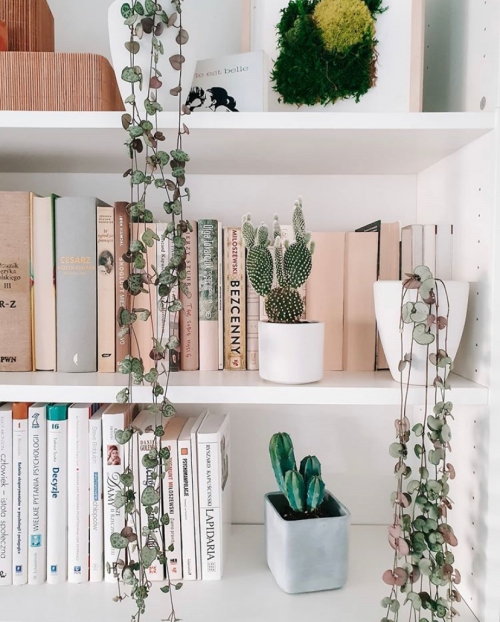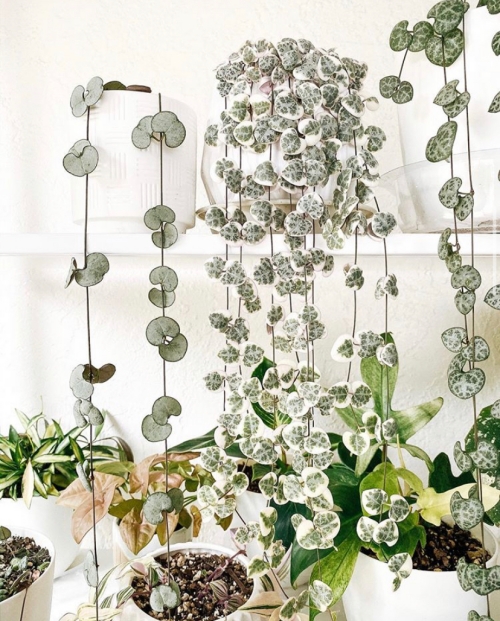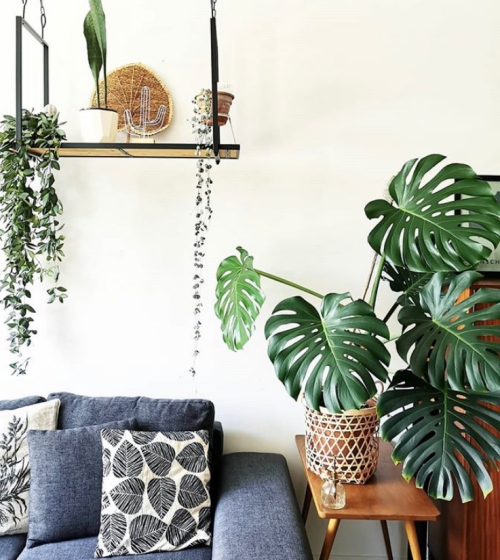
The Cutest Trailing Houseplant
I’m so excited to be featuring an absolutely adorable houseplant this month! I had been dreaming of owning this plant for so long and then one of my plant friends graciously offered to send me some cuttings. I was so excited to research everything about this plant so I could help it grow that I thought it would be the perfect plant to feature this month! Let’s learn together everything we need to know to care for this super cute trailing plant.
Introducing… The String of Hearts

Plant Level: Intermediate
Cost: $15-$50
Winner of the Cutest Trailing Houseplant (awarded by us)
String of Hearts
The String of Hearts’ botanical name is Ceropegia woodii. It also has many other nicknames such as rosary vine, sweetheart vine, chain of hearts, and hearts on a string. Native to southern Africa, This trailing beauty can reach lengths of us to 12 feet in its natural habitat. Indoors they can still trail to about 6 feet long! It was discovered by John Medly Wood who found it hanging off of rocks on a mountain. The plant was then named after him and slowly but surely became a very popular houseplant.
When you see those long chains of heart-shaped leaves with their bright purple backs you can’t help but smile! Let’s dive into everything we need to know to have a thriving String of Hearts.
Light:
This plant requires bright, indirect light to thrive. It can even adjust to small periods of direct sun during the day, but too much will burn the leaves. Place your String of Hearts in the sunniest room in your home, making sure that the whole plant, even the top, is receiving ample light. Once in the perfect place watch her quickly head towards the floor.
Rotate this plant every time you water to help ensure even growth all the way around. If you notice the leaves having large spaces between them or the leaves becoming pale this might be a sign that you need to increase the light. To supplement the light you can always add a grow light to your space.
Water:
The String of Hearts is similar to a succulent. This means that it prefers dry soil to moist or wet soil. Overwatering this plant will quickly lead to root rot. To avoid this and keep your precious plant happy, wait until the soil is almost completely dry before watering. When it’s time to water give this plant a thorough watering. Make sure that your pot has good drainage at the bottom. You’ll want to be able to see water easily flowing out when you water.
This plant will require less watering in the dormant, winter months and will prefer to be watered more often during the growing season. If needed, invest in a moisture meter, it helps immensely when trying to determine how wet/dry the soil of your plant is and if it’s time to water.
Soil:
Since this plant is a semi-succulent we recommend using a quality well-draining houseplant soil mixed with some cactus/succulent soil. It might be a good idea to also toss in some perlite or pumice for a little extra drainage.
Humidity:
The sweetheart vine can adapt to most household humidity levels. It might be a perfect addition to a room that doesn’t hold the rest of your tropical houseplants that insist on having a humidifier to stay looking lush and happy.
Fertilizer:
Use a quality houseplant fertilizer on your plant throughout spring and summer. Hold off during winter when the plant is more dormant and growth is slower.
Toxicity:
The String of Hearts is a non-toxic houseplant. However, the long, dangling strings might be tempting to tug on for some curious pets or children so make sure to keep it out of reach.
Varieties:
Variegated String of Hearts
Silver Glory
Propagation:
A String of Hearts plant is relatively easy to propagate. One option is to cut a strand and stick it in some water. Wait until a good amount of roots form and plant it up. You can also cut apart each pair of hearts from a vine, then stick the nodes straight onto soil. The two hearts will sit on top of the soil looking like butterfly wings. Keep the top of the soil moist until you see new growth forming then water as usual. The last way of propagating this plant is to cut off a strand of the plant and circle it up on top of some soil. Keep the top of the soil moist until you see new growth coming out of the strand. This is a great option if the top of your String of Hearts is looking a little bare.
Get your String of Hearts Here
Our favorite way to display the String of Hearts is trailing down furniture in a simple white planter.
Looking for more tips on caring for houseplants? Check out our favorite plants. Don’t forget to subscribe so you never miss out on a new plant to add to your home!















Your string of heart is eye dropping.!!!I wish i have that lushing string of heart !!!Good job for making it healthy..
Thank You!
Your SOH is so beautiful! Just ordered mine off Etsy, can’t wait for it to arrive! I hope I can keep mine looking as gorgeous as yours!
We believe in you!!